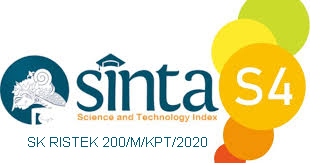Virtual Reality Architecture Oriented Wireless Connection For Future Generation Virtual Reality Devices
Abstract
Keywords
Full Text:
PDFReferences
Ahn, J. (2018). applied sciences Virtual Reality-Wireless Local Area Network : Wireless Connection-Oriented Virtual Reality Architecture for Next-Generation Virtual Reality Devices. https://doi.org/10.3390/app8010043
Al-Mussawi, R. Ma., & Farid, F. (2016). Computer-Based Technologies in Dentistry: Types and Applications. Journal of Dentistry (Tehran, Iran), 13(3), 215–222. Retrieved from http://www.ncbi.nlm.nih.gov/pubmed/28392819%0Ahttp://www.pubmedcentral.nih.gov/articlerender.fcgi?artid=PMC5376549
Foerster, R. M., Poth, C. H., Behler, C., Botsch, M., & Schneider, W. X. (2016). Using the virtual reality device Oculus Rift for neuropsychological assessment of visual processing capabilities. Scientific Reports, 6(April), 1–10. https://doi.org/10.1038/srep37016
Kadam, S. D., French, B. M., Kim, S., Morris-berry, C. M., Zimmerman, A. W., Blue, M. E., & Singer, H. S. (2013). Journal of Experimental Neuroscience. Journal of Experimental Neuroscience, 6, 93–99. https://doi.org/10.4137/JEN.S12979.TYPE
Ma, Q. L. (2010). Virtual Reality Applications in College Physical Education. Proceedings of the 2010 Conference on Computer Science in Sports, 311–314.
DOI: https://doi.org/10.31326/jisa.v3i1.500
Refbacks
- There are currently no refbacks.
Copyright (c) 2020 harry dhika, dicky kurnia putra

This work is licensed under a Creative Commons Attribution-ShareAlike 4.0 International License.
JOURNAL IDENTITY
Journal Name: JISA (Jurnal Informatika dan Sains)
e-ISSN: 2614-8404, p-ISSN: 2776-3234
Publisher: Program Studi Teknik Informatika Universitas Trilogi
Publication Schedule: June and December
Language: English
APC: The Journal Charges Fees for Publishing
Indexing: EBSCO , DOAJ, Google Scholar, Arsip Relawan Jurnal Indonesia, Directory of Research Journals Indexing, Index Copernicus International, PKP Index, Science and Technology Index (SINTA, S4) , Garuda Index
OAI address: http://trilogi.ac.id/journal/ks/index.php/JISA/oai
Contact: jisa@trilogi.ac.id
Sponsored by: DOI – Digital Object Identifier Crossref, Universitas Trilogi
In Collaboration With: Indonesian Artificial Intelligent Ecosystem(IAIE), Relawan Jurnal Indonesia, Jurnal Teknologi dan Sistem Komputer (JTSiskom)
JISA (Jurnal Informatika dan Sains) is Published by Program Studi Teknik Informatika, Universitas Trilogi under Creative Commons Attribution-ShareAlike 4.0 International License.


















